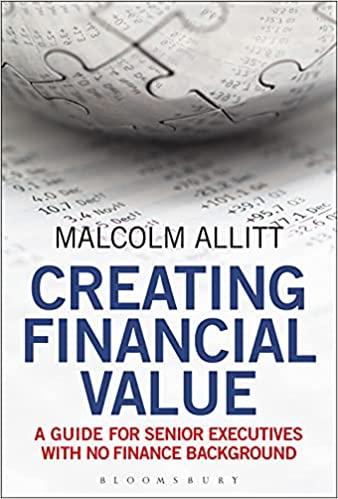Question
Cerberus Capital Management Acquires Chrysler Corporation According to the terms of the transaction, Cerberus would own 80.1 percent of Chrysler's auto manufacturing and financial services
Cerberus Capital Management Acquires Chrysler Corporation
According to the terms of the transaction, Cerberus would own 80.1 percent of Chrysler's auto manufacturing and financial services businesses in exchange for $7.4 billion in cash. Daimler would continue to own 19.9 percent of the new business, Chrysler Holdings LLC. Of the $7.4 billion, Daimler would receive $1.35 billion while the remaining $6.05 billion would be invested in Chrysler (i.e., $5.0 billion is to be invested in the auto manufacturing operation and $1.05 billion in the finance unit). Daimler also agreed to pay to Cerberus $1.6 billion to cover Chrysler's long-term debt and cumulative operating losses during the four months between the signing of the merger agreement and the actual closing. In acquiring Chrysler, Cerberus assumed responsibility for an estimated $18 billion in unfunded retiree pension and medical benefits. Daimler also agreed to loan Chrysler Holdings LLC $405 million.
The transaction is atypical of those involving private equity investors, which usually take public firms private, expecting to later sell them for a profit. The private equity firm pays for the acquisition by borrowing against the firm's assets or cash flow. However, the estimated size of Chrysler's retiree health-care liabilities and the uncertainty of future cash flows make borrowing impractical. Therefore, Cerberus agreed to invest its own funds in the business to keep it running while it restructured the business.
By going private, Cerberus would be able to focus on the long-term without the disruption of meeting quarterly earnings reports. Cerberus was counting on paring retiree health-care liabilities through aggressive negotiations with the United Auto Workers (UAW). Cerberus sought a deal similar to what the UAW accepted from Goodyear Tire and Rubber Company in late 2006. Under this agreement, the management of $1.2 billion in health-care liabilities was transferred to a fund managed by the UAW, with Goodyear contributing $1 billion in cash and Goodyear stock. By transferring responsibility for these liabilities to the UAW, Chrysler believed that it would be able to cut in half the $30 dollar per hour labor cost advantage enjoyed by Toyota. Cerberus also expected to benefit from melding Chrysler's financial unit with Cerberus's 51 percent ownership stake in GMAC, GM's former auto financing business. By consolidating the two businesses, Cerberus hoped to slash cost by eliminating duplicate jobs, combining overlapping operations such as data centers and field offices, and increasing the number of loans generated by combining back-office operations.
However, the 2008 credit market meltdown, severe recession, and subsequent free fall in auto sales threatened the financial viability of Chrysler, despite an infusion of U.S. government capital, and its leasing operations as well as GMAC. GMAC applied for commercial banking status to be able to borrow directly from the U.S. Federal Reserve. In late 2008, the U.S. Treasury purchased $6 billion in GMAC preferred stock to provide additional capital to the financially ailing firm. To avoid being classified as a bank holding company under direct government supervision, Cerberus reduced its ownership in 2009 to 14.9 percent of voting stock and 33 percent of total equity by distributing equity stakes to its coinvestors in GMAC. By surrendering its controlling interest in GMAC, it is less likely that Cerberus would be able to realize anticipated cost savings by combining the GMAC and Chrysler Financial operations. In early 2009, Chrysler entered into negotiations with Italian auto maker Fiat to gain access to the firm's technology in exchange for a 20 percent stake in Chrysler.
1. Which of the leading explanations of why deals sometimes fail to meet expectations best explains why the combination of Daimler and Chrysler failed? Explain your answer.
Step by Step Solution
There are 3 Steps involved in it
Step: 1

Get Instant Access to Expert-Tailored Solutions
See step-by-step solutions with expert insights and AI powered tools for academic success
Step: 2

Step: 3

Ace Your Homework with AI
Get the answers you need in no time with our AI-driven, step-by-step assistance
Get Started


